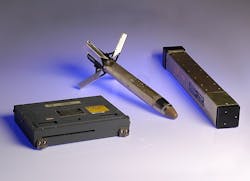Navy orders AN/ALE-55 electronic warfare (EW) towed decoys to protect combat jets from missiles
PATUXENT RIVER NAS, Md., 15 Dec. 2016.Electronic warfare (EW) experts at the BAE Systems Electronic Systems segment in Nashua, N.H., will build 253 AN/ALE-55 fiber optic towed decoys (FOTDs) to protect combat jets from missile attacks under terms of a $19.7 million U.S. Navy order announced Wednesday.
Officials of the Naval Air Systems Command at Patuxent River Naval Air Station, Md., are asking BAE Systems to build Lot VII of the airborne countermeasure, which is designed to protect the Navy and Marine Corps F/A-18E/F Super Hornet carrier-based jet fighter-bomber from radar-guided missiles.
The contract is to build one year's worth of AN/ALE-55 FOTD units for the Navy and Marine Corps. BAE Systems won a $20.9 million contract to build 284 Lot VI FOTD systems in December 2015, a $19.9 million contract to build 283 Lot V FOTD systems in November 2014, and a $28.2 million contract to build 262 Lot IV FOTD systems in November 2013. BAE Systems began full-rate production of the AN/ALE-55 in late 2011.
These orders are part of the U.S. military's Integrated Defense Electronic Countermeasures Radio Frequency Countermeasure program.
Related: BAE Systems helping Navy develop next-generation electronic warfare (EW) technologies
The AN/ALE-55 transmits complex electronic countermeasures signals from a transmitter that trails behind its combat jet to spoof incoming radar-guided anti-aircraft missiles.
The aircraft-towed decoy with onboard electronics works together with the Super Hornet's electronic warfare system to jam radar seekers in air-to-air missiles. The system also can lure incoming missiles away from their actual targets.
The ALE-55 detects a threat radar in its acquisition mode and uses radar jamming to prevent it from locking to a target. The ALE-55's electronic warfare package analyzes the threat, and the towed decoy emits the jamming signals to confuse the incoming missile's tracking radar. If an incoming missile locks on with radar, the ALE-55 analyzes the signal to determine the best jamming technique to break radar lock.
The ALE-55 system consists of an onboard electronic frequency converter (EFC) and a fiber-optic towed decoy. The EFC converts radio frequency signals sent from the plane’s electronic warfare system into data coded and transmitted via light to the fiber optic towed decoy.
Although the ALE-55 now is in use with the F/A-18E/F Super hornet, it can be adapted to a wide variety of combat aircraft with minimal modifications, BAE Systems officials say.
On this contract BAE Systems will do the work in Nashua, N.H.; Chelmsford, England; Rochester, N.Y.; Fremont and San Diego, Calif.; Landenburg, Pa.; Toledo, Ohio; and other U.S. locations, and should be finished by December 2018.
For more information contact BAE Systems Electronic Systems online at www.baesystems.com, or Naval Air Systems Command at www.navair.navy.mil.
Learn more: search the Aerospace & Defense Buyer's Guide for companies, new products, press releases, and videos

